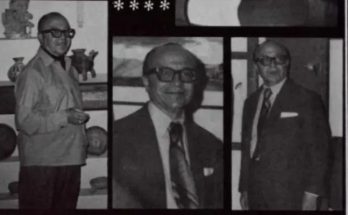By Luis Felipe Rodriguez
One of my great pleasures is looking at old photographs. I begin to discover details I did not notice before: the names of the businesses, the way people dress, in short, all the changes in San Miguel that I did not live through. I do not mean to say that I would have liked to lived then. I imagine what life was like back then: the tranquility of a small town where everyone knew each other, where everyone knows everything and, perhaps, then, it’s not so quiet anymore. As they say: «…small town, big hell.»
Something I have asked myself: what did the photographers, whether amateurs or professionals, think when they developed those plates? Were they aware of the era which their images would reach? Another question would be. Who took those photos?
In the books or magazines that have come down to us, we see many with the signature of the person who took them (Maldonado, Soto, etc.). On other occasions we find a number, which makes us suppose that whoever made them had a collection and a certain order. Other images have nothing. The latter are not totally reliable because with current technology, photos can be digitized and modified on the computer. This includes «restoring» possible damages that are present, coloring them, adding or removing people, elements or even eliminating the signature or password used by its author. As the old saying goes: “Whatever it was, it was.”
I would like to discuss the origins of photography in San Miguel.
Photography began in the 19th century with the experiments undertaken by Nicéphore Niépce, whom Louis Daguerre joined in December 1829. Daguerre, unlike Niépce, had developed a uniquely original procedure, the daguerreotype. It was expensive and difficult to manipulate and only produced a single non-replicating proof. Despite its shortcomings, it spread throughout the world, opening the door to photography in a definite way.
The daguerreotype is a process by which a positive image is obtained with a copper plate coated with silver iodide. After being exposed to light, the latent image was developed with mercury vapors, resulting in a finely detailed image with a delicate surface that had to be protected from abrasion with glass and sealed to prevent blackening on contact with air. It is worth noting that photography tried in its beginnings to imitate painting. The most famous photographers conceived their portraits as authentic traditional oil paintings.
George Eastman was directly responsible for the current extension of the camera. Eastman prepared a flexible paper support covered with a bath of pure gelatin with a gelatin bromide emulsion and made a simple device that he sold loaded with a hundred exposures. Development of the photos and the replacement was done in the factory, for which the complete camera had to be sent. The invention would end up being perfected with the nitrocellulose negative roll and the Kodak camera.
The first photographic laboratory in San Miguel was that of Don Federico Martínez, which he called “Daguerre,” on the corner of Plaza Principal and Reloj. In its beginnings, the art of photography was a mystery dominated by very few. Photographers would announce themselves in advance and later come to the city for temporary visits. On one occasion, as one of them was spotted by young Arturo Suárez García, son of a well-known merchant of the time, Don Victoriano Suárez Rangel. Don Victoriano had his store «La Esmeralda» on Juárez Street, in front San Francisco. When the visiting photographer shot a pair of portraits, young Arturo was so impressed by the process that he asked to be introduced into the mysteries of photography. It was an exciting, but not an easy process, because you had to be familiar with how the cameras and lenses work. And you also had to learn how to prepare the plates to make the negatives and then the printing. All of this was a fundamental part of handling the chemicals and exposure times in the dark room.
Arturo married Antonia Oliden Loredo in 1934 and they had a large family. Later, when Felipe Cossío del Pomar and Enrique Fernández Martínez restarted the Fine Arts school, moving it to what is now Instituto Allende, Arturo became the teacher of the photography class. This allowed him to keep abreast of new cameras and of the photography industry. Also this afforded him contact with great photographers like Mrs. Reva Brooks, wife of the great painter Leonard Brooks. (To be continued)




